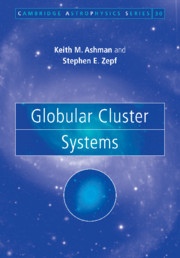Book contents
- Frontmatter
- Contents
- Preface
- 1 Introduction
- 2 Properties of globular clusters
- 3 The Galactic globular cluster system
- 4 Globular cluster systems in nearby galaxies
- 5 Properties of extragalactic globular cluster systems
- 6 Globular clusters and galaxy formation
- 7 The formation of globular clusters
- 8 Future prospects
- Appendix
- References
- Subject index
- Object index
2 - Properties of globular clusters
Published online by Cambridge University Press: 21 September 2009
- Frontmatter
- Contents
- Preface
- 1 Introduction
- 2 Properties of globular clusters
- 3 The Galactic globular cluster system
- 4 Globular cluster systems in nearby galaxies
- 5 Properties of extragalactic globular cluster systems
- 6 Globular clusters and galaxy formation
- 7 The formation of globular clusters
- 8 Future prospects
- Appendix
- References
- Subject index
- Object index
Summary
Like most astronomical objects, globular clusters exhibit a range of properties and characteristics, but certain features are common to the majority of them. Due to their relative proximity, globular clusters within the Milky Way are the best–studied, and most of the ‘typical’ properties described in this chapter are based on observations of these objects. Unless otherwise stated, the data used in this and the following chapter are taken from the McMaster catalog described by Harris (1996; see also Harris and Harris 1997). Differences between the globular clusters of the Milky Way and other galaxies are summarized at the end of this chapter.
Color–magnitude diagrams
The luminosity and temperature of a star are dependent on its mass, age, and chemical composition. Color–magnitude diagrams of globular clusters have long been the subject of intensive study because they reflect these fundamental properties of the constituent stars. Figure 2.1 shows the color–magnitude diagram of M5 and illustrates a number of the basic features of globular cluster color–magnitude diagrams. These include the main sequence, the giant branch, and the horizontal branch, each of which is discussed in the following subsections.
Main sequence
One of the key features of globular clusters is the well-defined main sequence extending from the turn–off to fainter magnitudes and redder colors (see Figure 2.1). Globular cluster stars on the main sequence derive their energy from the conversion of hydrogen to helium in the stellar core. The low–luminosity end of the main sequence shown in Figure 2.1 is determined by the magnitude limit of the observations.
- Type
- Chapter
- Information
- Globular Cluster Systems , pp. 5 - 30Publisher: Cambridge University PressPrint publication year: 1998
- 1
- Cited by



